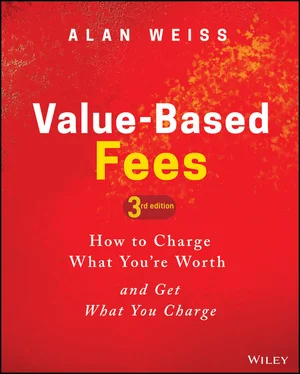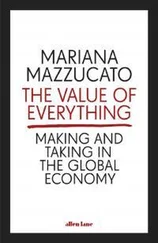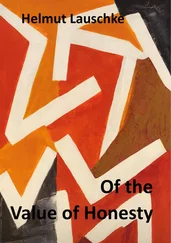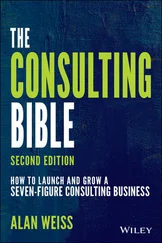However, the greater risk is that even with demonstrable success, the buyer feels alienated, disenfranchised, and apart from it. The fee in this case, despite success, will be paid grudgingly. For one thing, the client is now fearful of long-term dependence and doesn't want to incur huge costs each time the consultant's “expertise” is required to solve another problem. For another, the buyer does not feel the intrinsic ownership and sense of well-being that would emotionally overwhelm any reservations about costs. Third, from an ego perspective, the buyer will feel the need to insert some leverage into the relationship to retain the perceived upper hand and emphasize that the consultant serves at the buyer's pleasure (especially if the results are so visible that others in the organization are talking about them).
True partners never begrudge each other their proper due. In fact, there's an implicit trust that neither partner will take advantage of the other and that agreed-upon terms, conditions, and time frames are innately fair.
Fee pressure decreases with a sense of shared investment, shared accountabilities, and shared success. Figure 1.4shows the difference between a focus on a buyer and seller (top) who are locked into a battle over costs with only vague benefits established and two partners (bottom) who have agreed on tangible results where the fee is simply an intelligent and economical investment.
When the buyer simply views the consultant as another vendor providing certain expertise, the cost of acquisition becomes the key focus, because this is a commodity purchase (Who can provide the cheapest computer monitors per our specifications?). However, when the buyer's self-image and role are as a partner in the consulting process, the decision becomes one of return on investment, and the clearer the outcomes (under the conceptual agreement discussed earlier) and the more dramatic, the higher the investment that is justified.
This is particularly true when that investment includes the buyer and key organization people in the partnership. Some of the most successful consulting projects I've landed—and the ones most impervious to fee pressure—are those in which a “virtual consulting team” was formed comprising key client resources and myself. No educated buyer will want to underfund or hedge on that investment.

Figure 1.4 Costs from the Expert Versus Investment from the Partner
Alanism: Borrow $100,000 from a bank and you’re a customer. Borrow $10 million dollars and you’re a partner!
These are some of the key factors in shared success:
A “we” mentality from the first contact with the prospect
Literature, web sites, and promotional materials that talk about partnering and shared responsibilities
A formal description of “joint accountabilities” in the proposal itself 7
A strong focus on outcomes and business results, not on tasks or deliverables
Ample opportunity for the buyer and other key people to take credit and to bask in the success
Candor in tackling inevitable problems and setbacks
The consultant's being seen as an object of interest and center of expertise in the field
Err on the side of the client and buyer receiving more accolades for success than you. But also err on the side of higher fees and faster payment of those fees. That's the quid pro quo .
It really doesn't matter what the organization believes. What matters is what the current and future buyers believe. The danger of consultants trying to “do it alone” is that the client runs through this sequence:
1 Who's John Adams?
2 Get me that guy John Adams.
3 Get John Adams.
4 Get John Adams if you can.
5 Get someone close to John Adams.
6 Get me a young John Adams.
7 Who's John Adams?
In a true partnership that focuses on shared success, however, no buyer will try to eliminate one half of the successful combination.
One has to develop a philosophy about fees. They are not a “necessary evil” or a “dirty part of the job,” but rather a wonderful and appropriate exchange for the superb value you are delivering to the client. That exchange has a long tradition and represents the highest ethical canon of modern capitalism: agreed payment for agreed value.
Buyers tend to believe that they get what they pay for, and higher fees actually convey higher quality for most buyers. Higher fees also guarantee a higher level of buyer commitment, and commitment, not compliance, is key to producing a return-on-investment mentality rather than a cost-reducing mentality.
Brands tend to raise buyers' perception of quality still higher, which is why strategic marketing is an essential aspect of the consultant's repertoire.
The consultant must anticipate and plan to overcome objections about how other, less enlightened consultants have charged, are charging, or will charge. That is, literally, neither here nor there.
Leaving money on the table is the equivalent of burning money—you will never, ever recover it, and we are talking millions of dollars over one's career.
Finally, shared success—understood from the outset and achieved at the conclusion—is vital to the belief in consultant worth as part of a partnership with the buyer.
The One Percent Solution®: Believe in your own value, and build your perceived value in demonstrable ways every day. That is the fuel for the acceleration of fees . 8
1 1. At least many of these people had some justification in having experienced the Great Depression as a child or World War II.
2 2. I'm happy to report that my coaching has been effective and she currently owns three homes.
3 3. Just in case, the 49ers are a National Football League team.
4 4. In fact, I've written a book with a subtitle, “Give Me a Double Axis Chart and I Can Rule the World” (The Great Big Book of Process Visuals, Las Brisas Research Press).
5 5. I owned three, but I stopped buying them when they ceased making manual transmissions, because the car no longer met my need as a true sports car.
6 6. But do feel free to read the prior book in this series, How to Establish a Unique Brand in the Consulting Profession (Jossey-Bass/Pfeiffer, 2001).
7 7. See the author's How to Write a Proposal That's Accepted Every Time (Kennedy Information, 1999).
8 8. Improve by 1 percent a day, and in just 70 days, you're thrice as good.
CHAPTER 2 The Lunacy of Time-and-Materials Models: Who Wants to Be as Dumb as a Lawyer?
Million Dollar Consulting 1 was originally published in 1992, and my position that consultants should only charge by value and never by a time unit or numbers of people involved was a major disruption to the profession. Hence, this book in its original version soon followed to explain the approach in more detail.
Historically, consultants had billed for their services on the basis of time units, usually hourly rates or per diem assessments. There is no logical reason for doing so, but the underlying reasons seem to have included the following:
Other professionals had set a precedent, most notably lawyers and accountants, both of whom preceded consultants on the business stage. 2 (Architects, designers, and other professionals also charge in this manner.) Recently, some New York attorneys made headlines by moving rates to $1,000 per hour, which they readily conceded they didn't expect anyone to pay. Lawyers still actually bill in six-minute increments and will charge 55 cents if they mail a letter for you.
Читать дальше













